Peter Sagan looks like an obvious contender to win the points competition. In recent years the sight of him in the green jersey has become as much a cliché of the Tour de France as images of the peloton riding past a field of sunflowers. If he wins his sixth green jersey he will equal the record set by Erik Zabel in 2001.
Sagan has competition, a route that doesn’t help him as much as usual and a points scale tilted against him. Here’s a closer look at the competition, the points system and the sprinters as Dylan Groenwegen and Fernando Gaviria as the new generation looking to take on the establishment.
Points scale: This is a competition that takes shape over time. Few riders set out to win it from the start, they want stage wins first and foremost and then the green jersey will follow. Still look to those contesting the intermediate sprints in the opening days and those who sit them out to save energy for an indication of personal priorities. Let’s look at the points available each day:
- Flat stages (Stages 1,2,4,7,8,13,18,21) 50-30-20-18-16-14-12-10-8-7-6-5-4-3 and 2 points for the first 15 riders
- Hilly finish / Medium mountain stages (Stages 5,6,9,14,15,16): 30-25-22-19-17-15-13-11-9-7-6- 5-4-3-2 points
- Mountain Stages + individual TT (Stages 10,11,12,17,19, 20) : 20-17-15-13-11- 10-9-8-7-6-5-4-3-2-1 points
- Intermediate sprints: 20-17-15-13-11-10-9-8-7-6-5-4-3-2-1 points
This winner-takes-all aspect rewards winning the big bunch sprints. The scale is the same as last year and there are eight flat finishes which are perfect for the sprinters, one less than last year. The “Sagan” stages where he can score when others can’t aren’t so obvious, there’s Stage 5 to Quimper and Stage 6 at Mûr de Bretagne and then only Stage 15 to Carcassonne and even then the Pic de Nore is a mouthful to chew on, so he’ll have to contest the intermediate sprints too, including the mountains. To illustrate with a hypothetical example, imagine Dylan Groenewegen wins three stages and Sagan places third each time, the Dutchman is on 50 x 3 = 150 points, Sagan 20 x 3 = 60 points and if the Slovak won three intermediate sprints uncontested by Groenewegen he’d get 20 x 3 = 60 points: still 30 points behind. Sagan’s hope here is strength in diversity in that if Groenewegen wins 50 points one day, Greipel wins the next day and Gaviria the next such that no one sprinter runs away with the competition.

Having mentioned the maths, a quick look at Peter Sagan‘s status. He’s got a team in his service, Bora-Hansgrohe have just the riders he needs for a Tour stage (the classics are another matter) to guide him into position and there’s no cohabitation with another sprinter like Ackermann or Bennett, just climber Rafał Majka. They’ve worked well together as team mates, look at the 2016 Tour and Stage 17 to the Emosson Dam when Sagan joined the early break to tow it clear, helping Majka’s chances. The form seems good, he won a habitual stage in the Tour de Suisse although not the usual multiple stage wins and took the Slovakian national title after a solo breakaway for almost the entire length of the race. Even the UCI commissaires get zealous this time, the upshot of last year’s exclusion is there will be a dedicated video commissaire from the UCI to review TV coverage (and social media too so the GIF that keeps on giving could possibly absolve or condemn a rider) so decisions should be more informed.
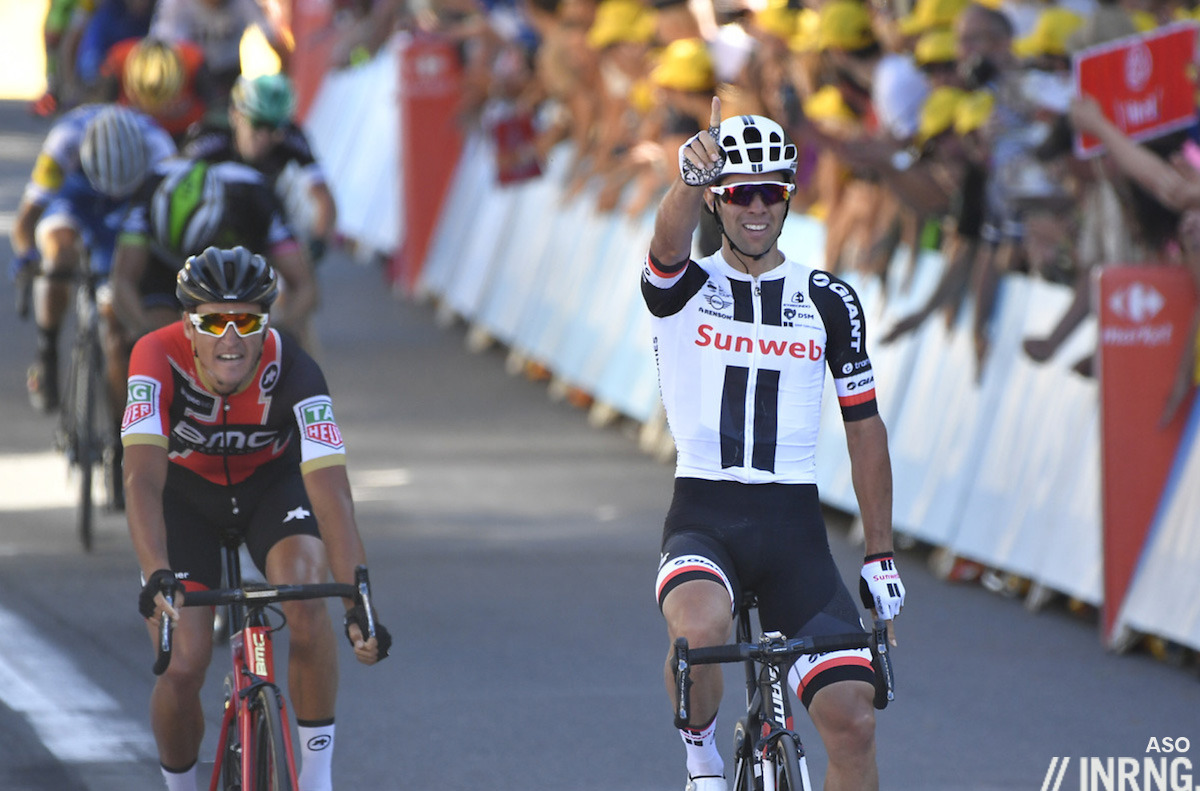
Michael Matthews won the jersey last year, helped by Sagan’s exclusion. Marcel Kittel was wearing the jersey too but fell in the Alps and the Australian was closing in on him too. Still how to beat Sagan? The Slovak seems a touch faster in the sprints although in a direct contest from the breakaway Matthews is one of the rare riders to have outfoxed him (Stage 10 to Revel in 2016) and Matthews can potentially outclimb Sagan too, handy for the two climbs at Mûr-de-Bretagne this year where Sagan has placed… but only when they’ve gone over once, this year the race climbs it once before finishing the second time. Matthews has team support too with Nikias Arndt and Søren Kragh Andersen.
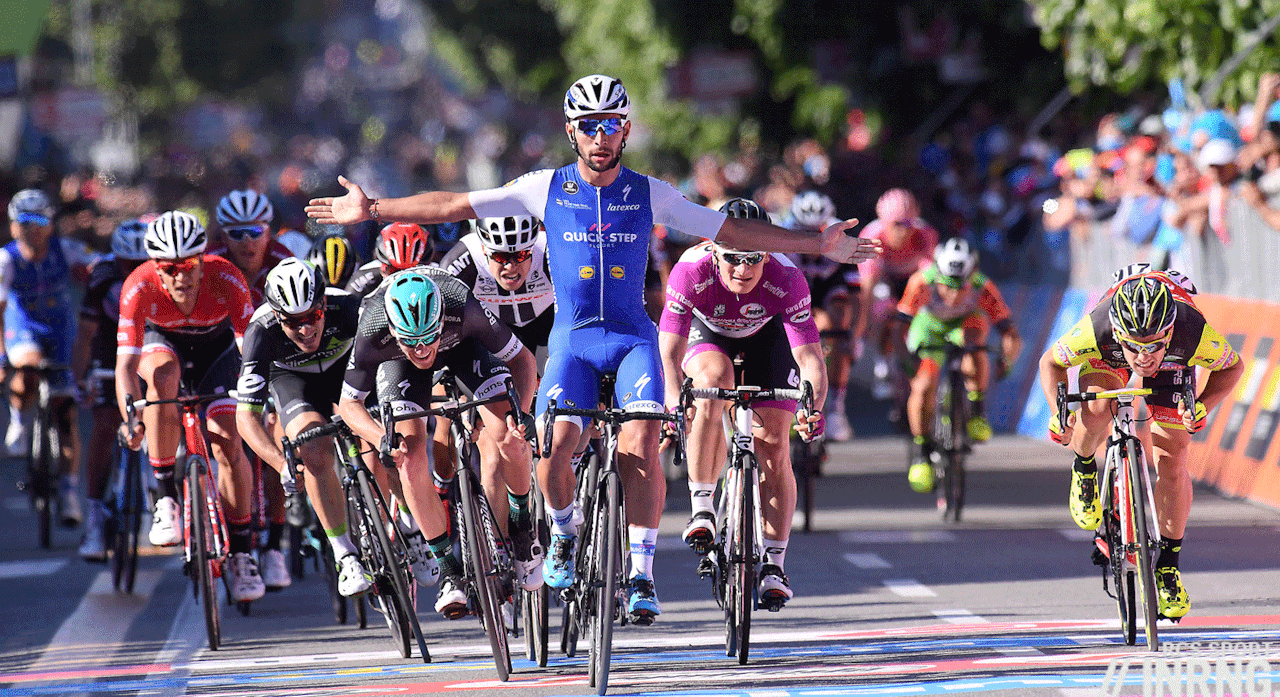
Fernando Gaviria is the new rival to Sagan. The Colombian took four stages of the Giro and the points jersey last year and is a versatile rider: fast enough to win dragstrip sprints, light enough to thrive in a hillier finish such as Stage 13 which takes a few sharp climbs just before reaching Valence. Quick Step offer plenty of support with warhorse Max Richeze as a specialist lead out but no Michael Mørkøv. So far, so good but he hasn’t won a sprint in Europe this year although breaking his hand in Tirreno-Adriatico explains plenty. However it’s his first time at the Tour and if he can take stage wins, hustling Sagan for intermediate sprints in the mountains isn’t something he’s used to.

Next come several sprinters. In recent years we’ve seen all the stars in the Tour de France only for one rider to dominate: Marcel Kittel took four five stage wins last year, Mark Cavendish four in 2016, André Greipel had four in 2015 and Kittel also four in 2014. There were no clues this would happen each time but if someone can establish a winning streak they’re going to collect beaucoup points. Kittel returns but has had a torrid season, two stage wins in Tirreno-Adriatico and it’s been the manner of his losses, sometimes in the mix but often out of the picture too. Katusha offer support with Rick Zabel a familiar lead out but not yet a feared one.
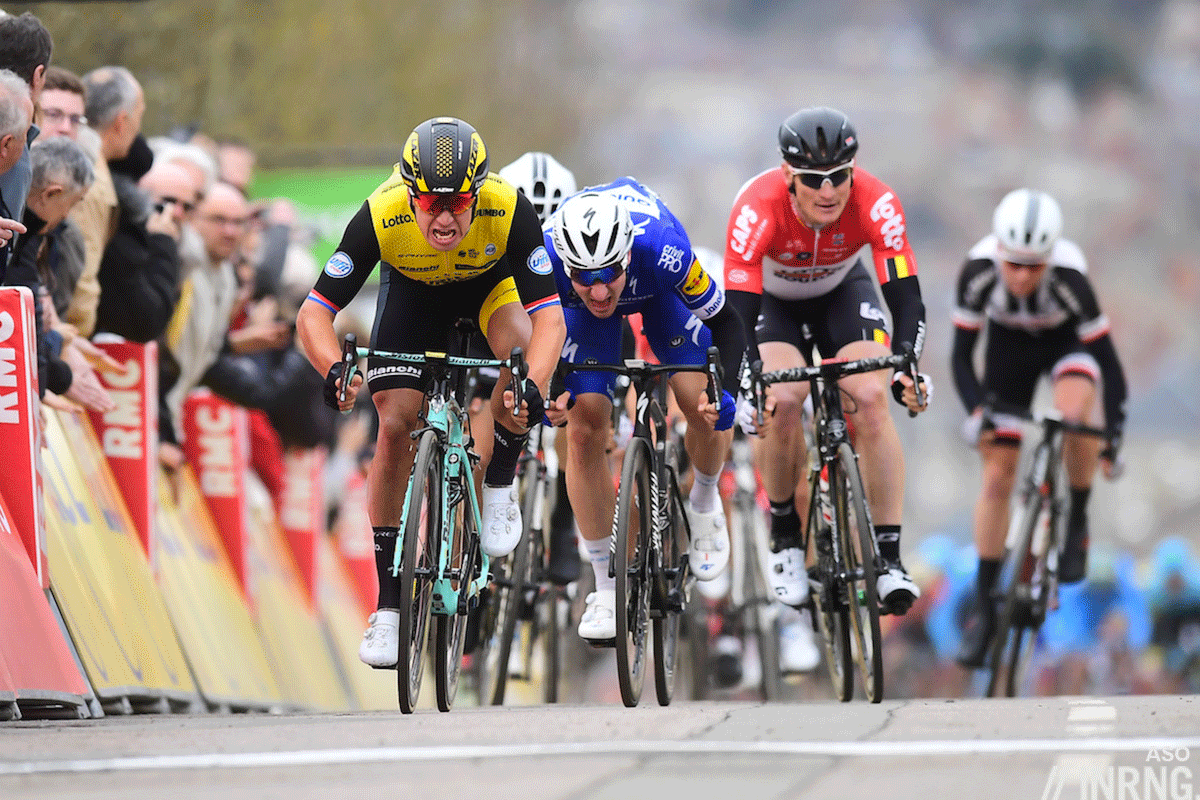
Dylan Groenewegen is on the up. He won on the Champs Elysées last year and has won a sprint in every stage race he’s done this year, including Paris-Nice (pictured) where he took on a frantic finish and an uphill rise to the line to win with ease, he’s become a lot more than a dragstrip specialist. Lotto-Jumbo have two GC riders but bring Timo Roosen and Amund Grøndahl Jansen as lead out.

What can Mark Cavendish do? Expectations are lower given the last two seasons have been marred by mononucleosis and many crashes. There’s the nagging sense his powers are waning but write him off today and you might as well start marinating a hat in case you’re forced to eat soon. Still, just one stage win would be a big return for him, let alone another four to equal Eddy Merckx’s tally of 34. He’s likely to focus solely on the stage wins and not contest the intermediate sprints.
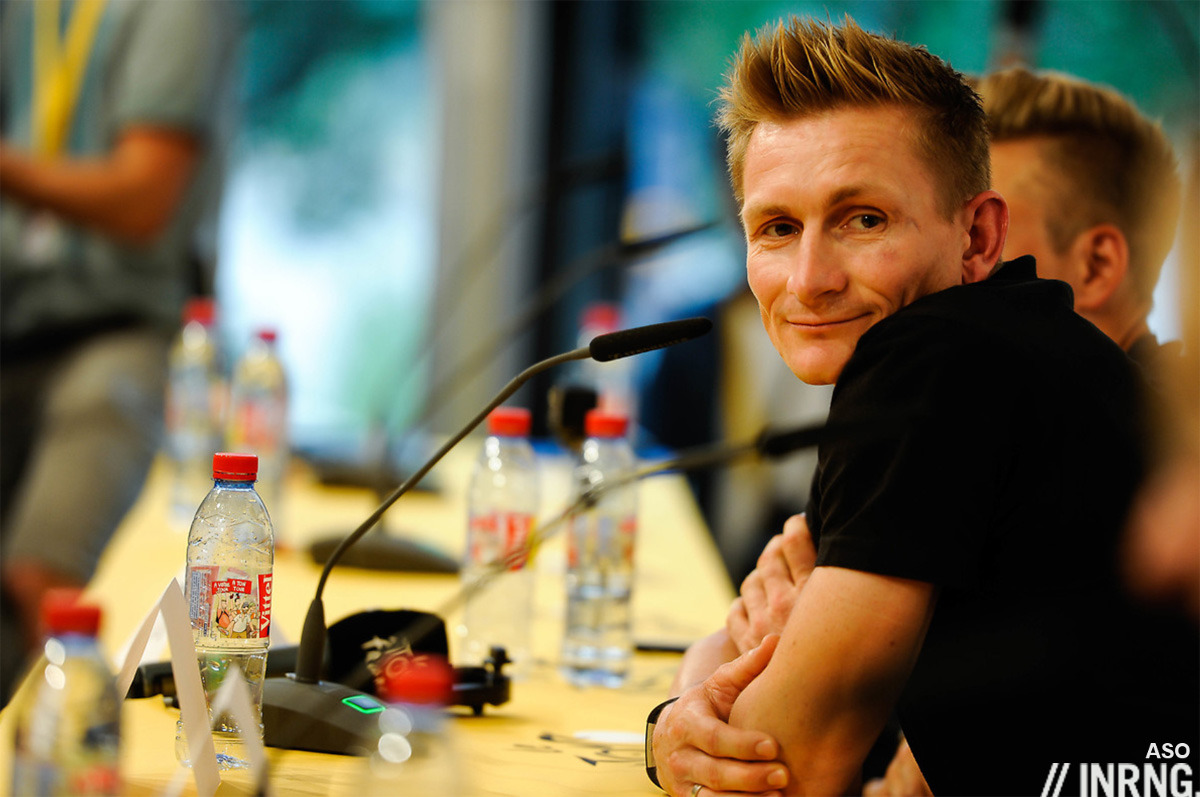
André Greipel had an amazing streak of winning a stage of every grand tour he started since 2008 but this ended last July. The friendly giant seems to be slowing but also had personal problems last year that would have been a big distraction. Now the other worry for him is his contract but this is a smaller concern, a stage win would do nicely. Still he finished second in the points competition last year, he’s consistent and persistent.
Alexander Kristoff is another of the big name sprinters but he hasn’t won in the Tour de France since 2014 despite trying every year since. He’s come close but if you want a banker for those 50 points on offer he’s not the most reassuring pick, especially as UAE-Emirates are not backing him with a luxurious train.
Edvald Boasson Hagen and Sonny Colbrelli did well on points last year finishing third and fifth respectively in the final classification. Colbrelli is getting better but the aim has to be a stage win, the same for EBH but what will the Norwegian do with Cavendish, if he is helping the Manx then he’ll forsake points. Arnaud Démare got a stage win in the Tour de Suisse beating all the sprinters. For him the green jersey looks elusive, just making Paris is the goal with a stage win along the way. John Degenkolb is more than a sprinter, after all he’s won Paris-Roubaix, so he can contest for the green jersey too but given the competition he might prefer to let others fight for it so he can save energy and try to win a sprint or maybe infiltrate a breakaway. The horrific accident of 2016 still looms large, he’s had wins since but needs a big one.
What chance for someone like Julian Alaphilippe who is an all rounder? Low because he’ll stay out of the way of Gaviria in the sprints and the scale is tilted towards the likely bunch sprint stages; which is why the GC contenders won’t feature, even if a rider like Alejandro Valverde places high a lot they won’t accumulate enough points.
| Peter Sagan | |
| – | |
| Fernando Gaviria, Dylan Groenewegen | |
| Michael Matthews | |
| Boasson Hagen |
History sprint:
- early editions of the Tour de France were based on points rather than time
- On the Tour’s 50th anniversary the points concept was revived and the classement par points was launched in 1953 with a green jersey
- Why green? Because it was the corporate tone of La Belle Jardinière, a Parisian department store and the original competition sponsor
- It’s always been green except for a red edition in 1968
- Erik Zabel holds the record with six wins, often collecting the prize on the Champs Elysées with his son Rick… who starts the race for the second time with Katusha
- Peter Sagan is second with five wins
- Strictly speaking it’s the points competition and not the “sprinters’ jersey” but only two overall winners have ever won green as well, Eddy Merckx of course (1969, 1971, 1972) and Bernard Hinault (1979)

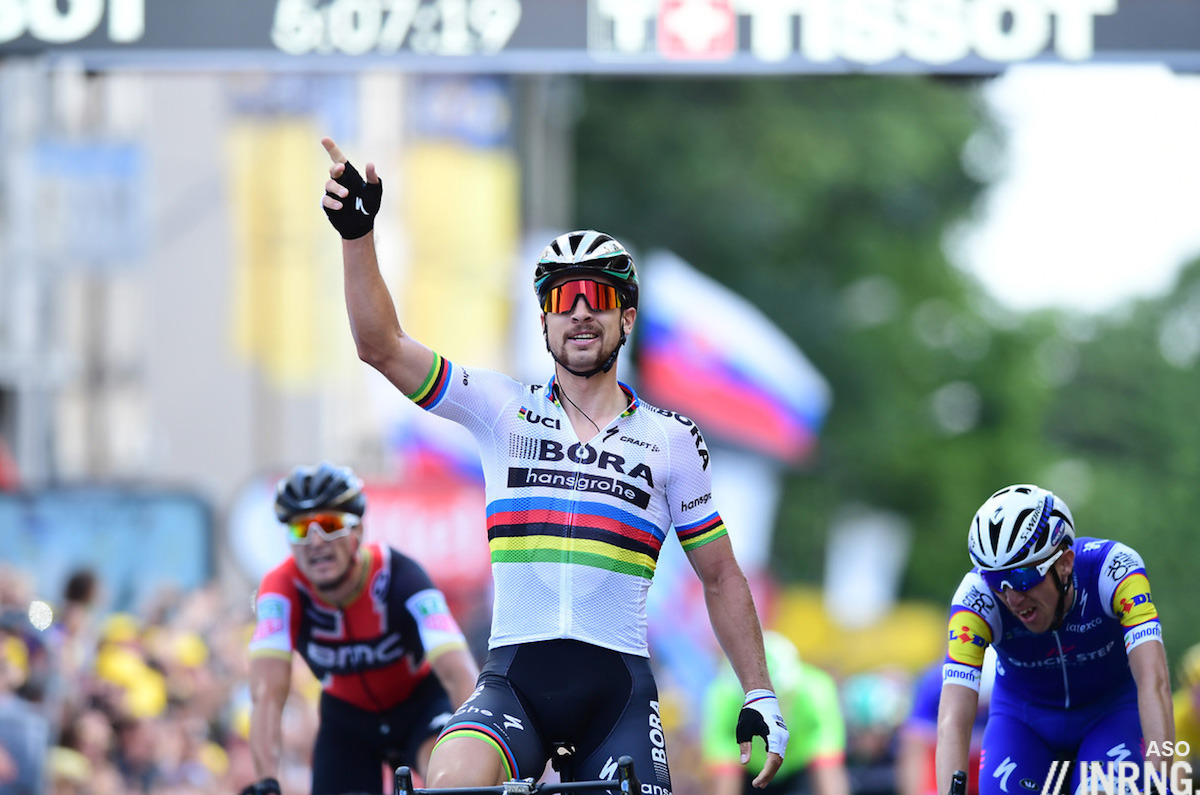
Are we sure Matthews will have help? I recall a recent interview somewhere with Sunweb bosses saying that they were there for GC reconnaissance and it was all about shepherding Dumoulin and that Matthews would have to fight for his own scraps when TD was safely inside 3kms to go.
Matthews is not defending his green jersey according to Sadhbh O’Shea today who claims to have spoken to him. Stage-hunting not jersey-hunting.
Inrng, minor typo: “write him off” (Cavendish) rather than “write him”. I don’t think he’d reply!
Excellent article, as usual.
Fixed, thanks.
Since it’s almost Tour time and there are usually new readers: corrections and suggestions are always welcome, not awkward. It’d be ideal to be error free but often things get typed too fast, there’s no editor etc. Think of it as helping the next reader.
” Marcel Kittel took four stage wins last year”
Five stages (stages 2, 6, 7, 10 and 11 ).
If only all bloggers were as mature and gracious…
BTW, loved the “GIF that keeps on giving” line.
compare to cyclingnews where most articles are so riddled with typos, spelling, grammar errors, false statements etc that you’d never bother trying to correct them all! inrng does pretty well despite not having the backup of an editor and most of all provides actual insightful commentary as well as funny one-liners about GIFS and hats 🙂
to any such new readers, stick around this is the best cycling site on the internet!
+1
Well said!
If Gaviria is a possible Green Jersey points contender, perhaps Sagan will have to take on the full might of Quick Step even on his ‘get-out’ breakaway stages – imagine if he’s got Gilbert, Terpstra, Lampaert et al on his tail, or possibly a swathe of Quick Steppers? Nightmare.
And, if the sprints could be shared round, could the ‘Sagan stages’ also – himself, Matthews, QS, etc?
I thoroughly enjoyed the Points battle last year and this year’s promises to be even better.
That was my thought about QS too but not sure Fernando Gaviria is quite there yet as a contender. If he can do well in the bunch gallops then the rest of the team are more than capable of preventing Peter Sagan harvesting intermediate sprint points plus challenging him on the harder days. Given recent evidence and comments from Tom Steel perhaps that is more for next year.
Great preview as always!
It’ll be fun to have almost all of the sprinters together for this Tour; should make for a very unpredictable battle for green, as they all seem pretty evenly matched.
One rider not mentioned in the preview that I’m curious about is Jasper Stuyven. Anyone have any idea what his plans are? Somehow I doubt he’s content to play second fiddle to Degenkolb in the flat stages.
Fernando Gaviria won 2 stages of the T of California (1&5) ahead of Sagan who did not win a stage this season. One thing about Sagan is when that kind of thing happens He has often shown He gets smart next time and wins.
Could be a Points Race to remember.
I’ve been thinking the same thing. Maybe I’m reading into it, but I sense that Sagan is really determined.
It is possible that by the first rest day, Sagan could be the holder of the Yellow, Green and Polka Dot Jerseys if he was his usual consistent self?
That would be extraordinary, and I have to think that even with time bonuses the BH team would have to do a very good TTT for Sagan to be in Yellow at that rest day. As for the Polka Dots, I suspect there will be some breakaway riders who will target that jersey during those early stages. Still, it’s possible, and would be very cool.
Probably worth adding the detail that Gaviria’s Giro successes were in 2017, not this year. I was trying to remember him winning 4 stages this year, but the picture gave it away as last.
8 flat stages is too many, there should be 6 at the most. More hilly & rolling stages would be a better spectacle for the viewers.
No chain rings for Kittel? I’d have thought if he has a chance of picking up 4 stage wins this must put him in with a shout of the green jersey?
I’m looking forward to a good points jersey competition, there seems a lot of sprinters this year so I can see Sagan muscled out of the top 5 on the flatter stages and the wins being shared about. There’s a lot of talk about Groenwegen but I”m not entirely convinced.
I can see Cavendish getting a win or two, and I’ve just got a feeling he may pinch yellow on the opening stage.
He also needs to get to the finish!
“The GIF that keeps on giving” – man I do so love this site 🙂
“Chateau!”, as UK Cycling Expert would no doubt say.
Can’t wait for the weekend. This edition looks like it’s going to be VERY tough, and there’s interesting things happening every day. Perfect.
I think only Sagan and Matthews will go for it properly unless as you say a sprinter finds themself with a bunch of wins and in the mix inadvertently. I think Gaviria will be happy with a stage win or two in this company and although Matthews is a better climber than Sagan I think he’ll be in the bottom reaches of the top 10 on flat days against Sagan being in the top 3 or even winning. So Sagan should win again. I’d much rather see all GT points jerseys go back to equal weighting for every stage. You’d end up with far more possible winners and a battle on every stage. I’d also cut down the points at the intermediate sprints or have it as a separate competition altogether.
As I understand it, you’re only allowed to have 4 jerseys per grand tour. So which do you lose to facilitate an intermediate sprints jersey as well?
Not every competition needs a jersey (Giro is an example of probably over doing the number of competitions).
You can do with a green helmet ; ) 😂
Jokes aside, it will do nicely with a daily podium appearance and a green number card.
I wouldn’t be fussed if an intermediate sprints competition had no jersey, or if they got rid of that rule, or if the got rid of the ‘not so young riders’ jersey.
But why no one mentions just doing away with the 4 jersey limitation? Or at least question it?
Really, a red sprinter’s jersey in ’68? Because of the spirit of the times?
Well played, sir.
It was the perennial spirit of the times: the sponsor changed and the new sponsor wanted red.
“you might as well start marinating a hat” Nice.
The only way I see Sagan not winning this is if he’s ejected again, so I’m not expecting a lot of green drama. Hopefully the sprinters all hit a high note, as they’ve each had spells this year and the sprint stages are a slugfest. I’d also like to see Cav get a stage (and not crash).
I was under the impression that La Belle Jardiniere was a garden machinery manufacturer, Wikipedia and other sources state this, was it also a department store? Perhaps the wikipedia is an error that has been repeated to become internet ‘fact’. I like to think there was once a maillot vert model lawnmower being used at speed in the gardens of France….
If you like geen lawnmowers. You should see this movie “The straight story ” The guy is making a long trip on a very small John Deere Green lawnmower
I absolutely love that movie! cheers
It was a large department store in Paris selling clothes which branched out across France but closed down in the 1970s.
Awesome preview as ever! Want to buy some kit to say thankyou – will you be restocking the t shirt?
Griepel should have spent less time last year producing his Go Gorilla song and more time on focussing on winning races.
How many of the sprinters can actually finish this year? Stage 17 seems set for a huge GC battle that could lead to a major exodus via the time cut. Particularly after the rough second week has already taken its toll. Can Groenewegen and Gaviria survive that? We know Kittel is the first to fall and Cav will be holding on for dear life. Démare should survive, but I seriously see that stage being a bloodbath.
They’ve specifically eased the time cut for this stage, it’s 25% like a time trial stage. Indeed though this is a hard route for the sprinters, a lot of the climbs are steeper than usual.
One or two sprinters may be sent home in that stage, but I don’t think it’s realistic for four sprinters to drop out on one stage. If those four sprinters all end up outside the time cut then they won’t be alone, and although it may have happened before that many riders have been sent home on a single stage, it seems to me that it’s more common for (virtually) everyone to be pardoned in that case, especially if they come across the finish line in large groups.
It’s almost impossible to see beyond Sagan for Green given his record, strengths and abilities.
One more small typo….
….Colbrelli is getting better but the aim has to be a stage win, the same for EBH but what will the Norwegian do with Cavendish, if he he
A double he he. Surprised that Demare is ranked quite low given his performance last year? I admit the FDJ team doesn’t look stellar!
I find it interesting there’s so much interest in the green jersey vs what seems so little in the polka-dot these daze. Wonder if that’s because too often the yellow jersey holder also has it or the guy in it is more of a climbing opportunist rather than a true king of the mountains? I seem to remember a time when the polka-dot was as big or a bigger deal than green.
I’ve wondered about that, too. I think it’s about the riders. Sagan is probably the most exciting rider of this time, and he’s going for green. Not so long ago, riders like Pantani were contesting for the polka dots. Also, the whole battle for the GC title has become so buttoned down, so that many of the best climbers are focused on the total time battle, and not getting to the top of the mountain first (unless it’s a mountain-top finish).
I’ve long wondered that too. Even when the likes of Chiappucci was getting on the podium it was still considered a big deal that he won the polka dots.
I suppose it could be partly because the GC is now skewed more towards climbers so there is less of a contest that is only for the best climbers.
A bump in prize money might help – although the green jersey still seems to have the status.
I think some of that status has come from Sagan making the contest his own and just seeming so impressive an all-rounder. Prior to that, for a few years, had it seemed something a bonus prize for the sprinters?
Certainly, there was a time when the jerseys were deemed more important than a stage win, but that focus seems to have changed considerably.
Is it because of the gradual shift in GC tactics, where the leaders wait until the last climb before making an attack, for fear of cracking on an early climb and losing too much time? So where previous years might have seen long range attacks from top GC riders, who would at least scoop up many KoM points if they failed, nowadays the field is left clear for the climbing opportunists to get all the mid-stage points, as you suggest.
Having said that, in the villages along the route in the Alps and Pyrenees, the polka dots seem to be on display at least as often as the yellow. Perhaps because it’s more fun for kids to paint?
In my opinion it’s because the best climbers now contest the win. Back in the day you’re referring to there’d be 100km plus of time trials. Chiapucci, Virenque, Herrera et al had no choice but to aim for the polka dots. If that was the case now the likes of Quintana, Landa, Bardet etc would be in the lower half of the top 10 at best and taking aim at the polka dots for something to do whilst Dumoulin coasted to a win and Tony Martin desperately tried to cling on to a place on the podium!
I think where you have a situation where you can call up a doctor and ask him if you should chase a breakaway, and based on VAM, speed, distance etc. And they can call back and say the break is doomed then you’re not going to have as many romantic dashes by mountain climbers.
I remember when you had the likes of Miller and Pantani that would make these drastic attacks.
They might not win the stage, but they would win the hearts of the viewers and spectators. The maillot à pois was then their trophy. It’s changed because the Postal train started to mow them down, and the victors were never important riders. They never touched the GC with their rides.
I suppose there is also the Tommy Voeckler effect. Never a great mountain climber he would end up with Polka-dots because he’d break away in the mountains win yellow and then be relegated to the mountains jersey. So it didn’t really feel like a real celebration of climbing.
Looks like a great line up – almost every big sprint name except Elia Viviani. Is Gaviria that much better/safer pick for some stage wins than Viviani that QS left him at home, could they have brought them both? or is there another reason for his absence that I have missed?
Should be some great sprints, and a real competition for Green.
My assumption (and I think what the team said) is that Viviani got the Giro, and I assume may do the Vuelta. It also seems that having two designated sprinters may not be great for team chemistry. Finally, I think the potential of Gaviria is to be a truly dominant sprinter, in a way that I don’t think Viviani has been or could be.
I can’t think of any team that’s had two ‘sprinter’ who would expect a train working for them. The dynamics wouldn’t work and who would ride whose wheel.
I must admit that I’m not entirely convinced by Gaviria over Viviani. Neither have been entirely dominant, but both have had some excellent results. Though perhaps I would fancy Gaviria to get over a mountain or two, whereas I think Viviani needs to train for mountains, at the expense of his speed. This certainly seemed the case at Sky, though they are not exactly the sprint train you’d want to ride behind.
Viviani has had time to be dominant (age 29), while Gaviria is still at an age where he’s learning the ins and out of World Tour positioning and gamesmanship (23). Gaviria appears to have the potential to be THE dominant sprinter in the coming years.
Uh Matthews only outfoxed Sagan with the help of 2-3 teammates back in 2016.